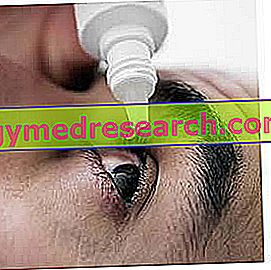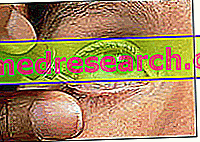Generality Retinal detachment is a very serious condition, which occurs when the inner membrane of the eye detaches from its supporting tissues. Retinal detachment can occur with the vision of light beams (photopsias) and / or mobile corpuscles (myopia), associated with blurring and sudden and dramatic reduction in vision
Category eye health
Definition of eye drops Eye drops are drugs or natural preparations to be administered in the eye in the form of drops. There are many types of eye drops: some are intended for the treatment of ophthalmic pathologies (eg glaucoma, uveitis, etc.), while others are reserved for the improvement of non-pathological eye disorders (eg red eyes, dry eyes, etc
Ophthalmic ointment The ophthalmic ointment appears as a soft and creamy preparation, to be spread inside the eye and / or on the eyelid. In addition to the active ingredient, the eye ointments are enriched with excipients that are essential to adjust the pH of the substance to that of the eye and preserve the product
Introduction Corneal topography is the diagnostic test used to obtain the topographic map of the cornea . More in detail, the execution of the corneal topography allows the study of the shape and characteristics of the cornea, thus allowing the identification of any defects or pathologies affecting this region of the eye
What is uveitis? Uveitis is an inflammatory process affecting the uvea , the thin vascular tunic of the eye that is interposed between the external ocular membrane (sclera and cornea) and the retina. Although the term "uveitis" expresses the sole inflammation of the uvea, very often this word is improperly used to indicate inflammatory processes affecting other ocular structures, such as for example retina, sclera and cornea
Uveitis and eye damage Uveitis is a generic inflammation of the uveal tract, the thin vascular membrane composed of three ocular sheets (choroid, ciliary and crystalline body) that separate the cornea and sclera from the retina. Uveitis constitutes an optical eye emergency in all respects: when not treated properly, the disease can spread to other neighboring ocular structures - such as cornea, iris and retina - causing exaggerated and sometimes irreversible damage, first of all compromising the vision and blindness
What is Jetrea Jetrea - Ocriplasmin and what is it used for? Jetrea is a medicine that contains the active substance ocriplasmin. It is indicated in adults for the treatment of vitreomacular traction (VMT), an eye disease that can cause severe visual disturbances. How is Jetrea - Ocriplasmin used? Jetrea is a concentrate that is made up into a solution for ocular injection
In some diseases, eye pain worsens with exposure to sunlight and intense artificial lighting. This annoying sensation, in particular, can be found in case of uveitis, corneal abrasions, conjunctivitis, keratitis and acute glaucoma. In addition, solar ophthalmodynia may depend on meningitis, headache and various febrile states
In summer, like the skin, even the eyes need protection. Exposure to ultraviolet rays, in fact, can favor the progressive opacification of the crystalline lens , a structure that filters and projects light onto the retina. Furthermore, solar radiation is implicated in the induction or progression of photokeratitis , retinopathy and age- related macular degeneration
In case of pollen allergy, it is not advisable to use decongestant eye drops based on natural plant extracts, such as chamomile, mallow and cornflower. The risk, in fact, is that they aggravate the allergic reaction. Chamomile and cornflower, in fact, belong to the Asteraceae family (also called Compositae) and if conjunctivitis is triggered by their own pollens, certainly these eye drops will not guarantee relief
Eye allergies do not always depend on a picnic on a beautiful flowery lawn. Some of the most common allergens, in fact, are found right at home: hair of cats and dogs , dust mites and molds . Today, the houses are perfectly isolated, limiting a change of air. This makes them, in a paradoxical way, less healthy, since the ideal conditions are created for allergens to concentrate










